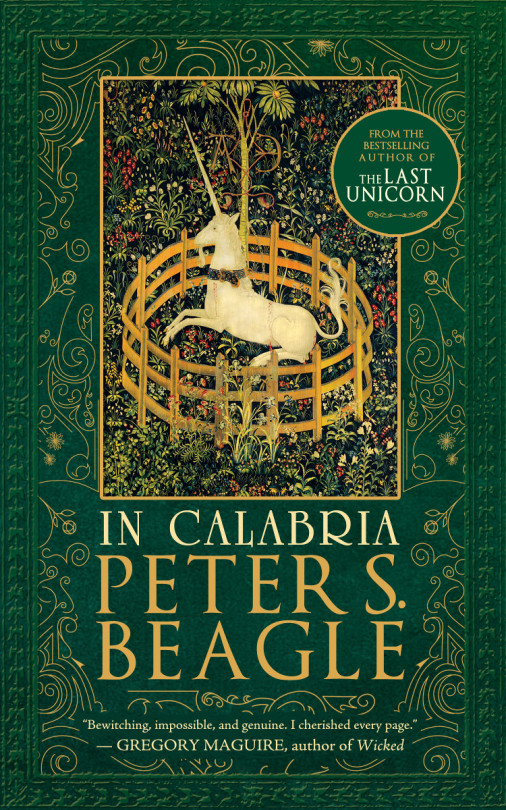The remarkable Peter S. Beagle’s THE OVERNEATH is a triumph
The emphatic praise for Peter S. Beagle’s recommend THE OVERNEATH continues.

On the B&N SCI-FI & FANTASY BLOG, Ceridwen Christensen praises the collection.
More than anything else—his unfailingly beautiful prose, his ability to weave threads of emotional truth into stories of the fantastic, his knack for writing stories that land with a soft touch and leave the impact of a hammer blow—Peter S. Beagle’s long literary career has been defined by unicorns.
There’s the protagonist of his most famous work, The Last Unicorn (called Lady Amalthea when in human guise), who is perhaps the most famous unicorn of all. Just last year, he published IN CALABRIA, a slender, wistful novel about the appearance of unicorns in a small Italian town. It inverts many of The Last Unicorn‘s themes, and serves as an interesting late-career mirror to a book that is now nearly 50 years old. The author seems to be in the process of the mythological well he drew from so often in those early days. The well is deep and clear, and its waters fortifying.
His new short story collection, THE OVERNEATH, includes three stories about unicorns, two of them hardly of the beautiful, immortal Western sort. “My Son Heydari and the Karkadann” is a grousing, exasperated story told by a father about his foolish boy, who once nursed a karkadann, a bestial Persian unicorn, back to health. “The Story of Kao Yu” follows a traveling judge living under the Emperor Yao, and his unspoken and largely inexplicable relationship with a chi-lin, an almost dragon-like Chinese unicorn, who occasionally appears to render judgement in Kao’s court. This is unicorn as a sort of social superego, and Kao’s relationship with a comely thief throws the judge’s relationship with the law into disequilibrium.

Unicorns aren’t the only creatures you’ll find in this book, which takes its name from an inter-dimensional plane in “The Way It Works Out and All,” a metafictional story about a fellow fantasy writer, the late Avram Davidson, who reveals he can travel through the (somewhat unreliable) otherland of the Overneath to anywhere on the planet. “Trinity County, CA: You’ll Want to Come Again and We’ll Be Glad to See You!” follows a group of do-gooders trying to rescue exotic pets—pets that turn out to be dragons. The aching “Music, When Soft Voices Die” is a steampunk-y story about a medical student who builds a radio of sorts, tuned into the unknown, in Victorian England.
THE OVERNEATH is a lovely collection that, like its namesake, manages to be everywhere at once. Aliens, dragons, unicorns, supernatural fish tanks, cursed queens, and matriculating magicians: all find their place in Beagle’s sweet grimoire.
Ian White at STARBURST awards the book 10/10 stars.
Peter S. Beagle is a remarkable writer. Almost half a century after the release of the book that made him famous – The Last Unicorn – and now in his 78th year, he continues to produce exceptional work and The Overneath, an enchanting collection of short stories which – fans won’t be surprised to hear – also includes one or two new tales about unicorns, will only consolidate his legend even further. This anthology is a triumph.
<snip>
In a collection where every tale is as good as the one that preceded it, it’s hard to choose favourites but there are three that, from a personal point-of-view, really stand out from the rest of the pack: ‘Underbridge’, about the real-life (well, kind of) Fremont Bridge Troll is a fantastic story about a University professor in crisis who becomes obsessed by the concrete Troll that is a local landmark (with unexpected results)… ‘Kaskia’, about an unhappily married man who begins messaging an alien on an unusual new laptop… and ‘Music, When Soft Voices Die’ which has a gentle steampunk sensibility wrapped around a central theme that hits you like a sledgehammer.
Maybe that’s what is so compelling about Beagle’s prose. He takes the extraordinary, makes it real, makes us care, and then swerves us into entirely unexpected territory. His storytelling is like the weaving of a spell – elegant, hypnotic and deeply exciting – but there’s an edge to it, a dangerousness, and an acute wisdom about the risks taken by the human heart. Absolutely breathtaking.

Photo: Rina Weisman
For READ WELL, Suncerae Smith enjoys the volume.
he author of THE LAST UNICORN presents a series of lyrical short stories, containing many new and previously uncollected works. Easily nine-tenths of this book consists of 5-star stories that will hold you fast and infuse your imagination. With a well-known wizard, three flavors of unicorns, fire-breathing cannibal dragons, a troll, and judges and scholars and queens and beggars, these tales are diverse in tone and subject matter, but all are pure enchantment!
<snip>
The beginning of each short story includes brief commentary from the author, which not only provides insights into the story it proceeds, but are so genuine that they seem to give a glimpse into the humble mind of the author, who claims that his stories decide not only when to write themselves, but also what happens, as if he has no part in the matter.
Recommended for all fans of fantasy that’s full of wonder and charm and magic!
LOCUS (NOVEMBER 2017, ISSUE 682) delivers a pair of reviews for THE OVERNEATH.
by Gary K. Wolfe:
Peter
S. Beagle’s late career has been something of a marvel, shifting
between deeply resonant and apparently autobiographical fictions like
‘‘The Rabbi’s Hobby’’ and ‘‘The Rock in the Park’’
(both in his earlier Tachyon collection SLEIGHT OF HAND) with
occasional revisits to the greatest-hits territory of THE LAST
UNICORN or THE INNKEEPER’S SONG. His new collection, THE OVERNEATH,
tends toward the latter, with two more Schmendrick stories (‘‘The
Green-Eyed Boy’’ and ‘‘Schmendrick Alone’’, to go with
earlier stories like ‘‘The Woman Who Married the Man in the
Moon’’), three tales that deal with different varieties of
unicorns (Chinese in ‘‘The Story of Kao Yu’’, Persian in ‘‘My
Son Heydari and the Karkadann,’’ North American in ‘‘Olfert
Dapper’s Day’’, in which an exiled quack Dutch physician thinks
he sees one in 17th-century Maine), and one story set in the world of
The Innkeeper’s Song (‘‘Great-Grandmother in the Cellar’’).
For the most part, Beagle is less visible in these tales than in many
of his more recent ones, although there is a rather touching tribute
to his old friend Avram Davidson in ‘‘The Way It Works Out and
All’’, in which Davidson’s famously mercurial and far-reaching
mind is translated into actual geography, as Davidson sends postcards
from places he could not possibly have been, having discovered a kind
of subreality called the ‘‘overneath.’’
<snip>
While
Avram Davidson is the only acknowledged literary influence here (and
a central character in ‘‘The Way it Works Out and All’’),
there’s more than a touch of Sturgeon in ‘‘Kaskia’’, in
which the lonely grocery clerk of the title meets, through his
mysterious new computer, an equally lonely figure named Kaskia, whose
role is similar to that of the alien in Sturgeon’s ‘‘A Saucer
of Loneliness’’. And the one steampunk story, which quickly
abandons its Victorian pseudoscience rationale (something called
‘‘etheric telegraphy’’) in favor of the folk wisdom of
Turkish hodja, has at its center a ramshackle invention,
intended to enable instant international communication, which instead
somehow picks up the voices of people apparently long dead. As
steampunk it’s completely ersatz, but Beagle’s evocation
of those random lost voices is one of the most haunting evocations of
his capacity for giving
voices to the unheard.
by Faren Miller:
Crows
and magpies – and a certain breed of writer – share a lively,
wide-ranging curiosity that’s linked to a fascination with things:
trinkets for birds, bits of fact and fancy for humans. Dar Oakley
works his stuff into nests. In ‘‘Underbridge’’ (Beagle’s
story about a wandering, untenured professor and a massive statue
known as the Troll), when a scholar meets a guy who feeds a Troll raw
meat, ‘‘an old Norse poem suddenly came to him, the earliest
reference his magpie mind could dredge up.’’‘‘The
Way It Works Out and All’’ gives THE OVERNEATH its title, when
Beagle imagines old friend and mentor Avram Davidson walking out of
the men’s room in Grand Central Station and into the Overneath: a
place that’s also a state of mind, and a way to leap around within
(or between) worlds. This alternate-Avram describes it as ‘‘the
sub-basement of reality – all those pipes and valves and tunnels
and couplings, sewers and tubes… the everything other than
everything.’’ There’s room enough for comedy and horror,
beauty, wonderment and more.
For more info on THE OVERNEATH, visit the Tachyon page.
Cover design by Elizabeth Story
For more info about IN CALABRIA, visit the Tachyon page.
Cover design by Elizabeth Story
